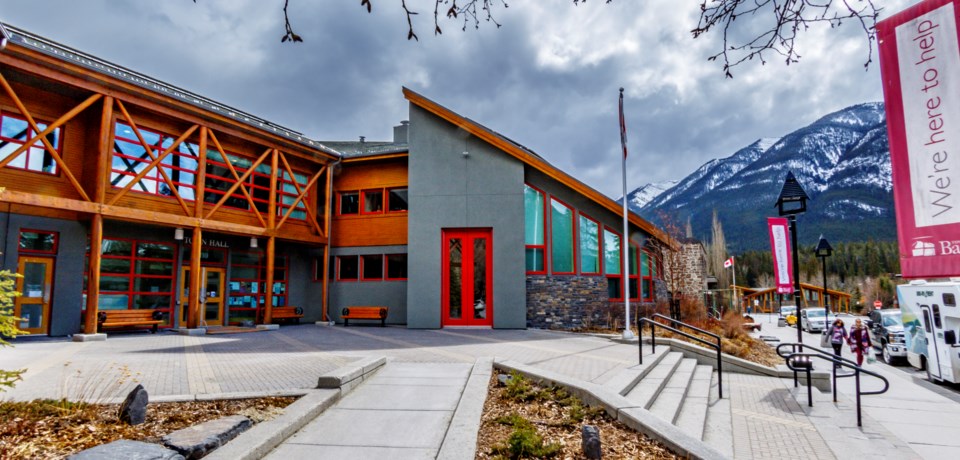BANFF – The Town of Banff is continuing to push Parks Canada for lands for intercept parking lots to help ease congestion in the national park tourist town.
In its formal response to the draft 2021 management plan for Banff National Park, the municipality assumes vehicle volumes will continue to rise without the development of further infrastructure or a significant increase in the use of mass transit.
Officials say this ultimately leads to the question of where vehicles should park.
They maintain lands located with the railway and commercial services districts, as well as areas adjacent to Compound Road near the east entrance to Banff “would be ideal for some form of intercept parking.”
“Conversely, if vehicles are intercepted outside of the national park – ideally down the Bow Valley through to Calgary – and visitors arrive to the national park via mass transit or shuttle options, then there is less need to worry about parking management at specific destinations and key attractions,” states the Town’s response document.
Parks Canada has long said no to use of lands for parking on the east entrance to town given there is a critical wildlife corridor running through the area used by animals such as elk, bears and wolves.
The Town is looking for Parks Canada to provide a clearer future policy direction in the Banff park management that speaks to a more integrated, park-wide transportation vision.
For example, they point to a section of the draft plan that states Banff National Park needs to go beyond accommodating increasing visitor demand with more traffic-related infrastructure for a sustainable future.
“Instead, the strategy is aimed at a system that goes beyond buses and parking lots,” states the draft plan.
“Rather than relying solely on large-scale mass transit and built infrastructure, it would be comprised of multiple medium and small-scale components that can be assembled, added to, increased or decreased, as visitor preference, circumstances and technology change.”
In the Town of Banff’s view, it is not entirely clear what this means.
“By discounting buses and parking lots it appears the plan fails to account for intercept parking and other sustainable modes of transportation,” states the municipality in its response document.
“We believe this is not what was intended, and that a strategy is required for a cost effective, attractive alternative to driving.”
Over the past decade, visitation to Banff National Park has increased by 30 per cent to more than 4.1 million visitors a year, with the Lake Louise area seeing unprecedented growth in visitation.
Parks Canada has appointed an expert panel to come up with a fundamental top-to-bottom overhaul of the way people access, experience and move around Banff National Park.
Municipal officials say transportation has a part to play in all aspects of how people choose to access and use the national park and a good system responds to many and varying needs and priorities.
“However, work needs to commence on this initiative immediately, instead of waiting another 10 years,” states the Town of Banff’s document.
“Without a path to achieve those changes, we will continue to have cars clogging roads, with transit, cycling, and walking relegated to the margins.”
High visitation puts pressure on transportation systems and traffic congestion is becoming increasingly challenging in both the Banff townsite and at tourist hot spots throughout the park such as Moraine Lake, Lake Louise and Johnston Canyon.
“We remain concerned that there will be funding, logistical, environmental, and geographic constraints in terms of what infrastructure can be provided,” states the Town’s document.
“Despite these constraints, we believe meaningful action including new infrastructure is essential to the continued success of the Banff National Park transportation network.”
The Town of Banff also calls on Parks Canada to lead and facilitate a cultural shift to encourage visitors, employees, and residents to use alternative transportation, both within the national park and neighbouring areas to get to the park.
Officials say ensuring that convenient and reliable opportunities for alternative transportation exist as the first step, the next is to market those opportunities and encourage their use.
“Limited parking combined with high mode share of private vehicles will undoubtedly continue to create severe traffic congestion, possible damage to natural resources, and negative impacts to visitor experience,” the document states.
“It is already recognized that there are shared challenges and initiatives, however, more clearly defined management strategies need to be developed and implemented to ensure that these capacities are not exceeded.”
The Town is also seeking clarification on what specific strategies are to be considered for making more efficient and effective use of existing parking infrastructure during peak periods such as disincentives, time limits or reservations.
The municipality suggests other tactics might include differential fees for vehicles at the gate. For example, pay as you go, pay parking, licence plate recognition technology to enable automated charging for visitors versus drive-through traffic, and subsidizing mass transit.
“The proposed strategy for moving people sustainably seems like a missed opportunity in its current form given this management plan will guide decision-making for the next 10 years,” states the document.
The draft management plan for Banff National Park was released for public review in April 14 and the public engagement period ended July 7.
Parks Canada officials say the results of public engagement will be analyzed and used to finalize the management plan.
Justin Brisbane, a spokesperson for Banff National Park, said the plan is to table the management plan in parliament by spring 2022.
“All of the comments and input received will be considered in the development of the park’s final management plan,” he said.
People should check regularly letstalkmountainparks.ca for updates on what Parks Canada heard through public engagement, important milestones in the management planning process, and further opportunities to help shape the future of Banff.




